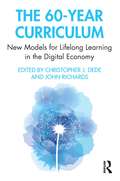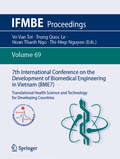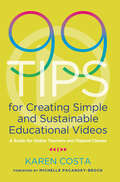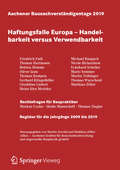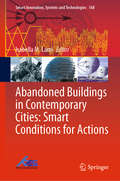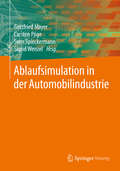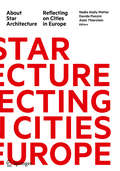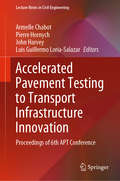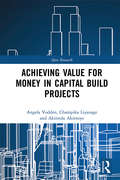- Table View
- List View
The 60-Year Curriculum: New Models for Lifelong Learning in the Digital Economy
by Christopher J. DedeThe 60-Year Curriculum explores models and strategies for lifelong learning in an era of profound economic disruption and reinvention. Over the next half-century, globalization, regional threats to sustainability, climate change, and technologies such as artificial intelligence and data mining will transform our education and workforce sectors. In turn, higher education must shift to offer every student life-wide opportunities for the continuous upskilling they will need to achieve decades of worthwhile employability. This cutting-edge book describes the evolution of new models—covering computer science, inclusive design, critical thinking, civics, and more—by which universities can increase learners’ trajectories across multiple careers from mid-adolescence to retirement. Stakeholders in workforce development, curriculum and instructional design, lifelong learning, and higher and continuing education will find a unique synthesis offering valuable insights and actionable next steps.
The 60-Year Curriculum: New Models for Lifelong Learning in the Digital Economy
by Christopher J. Dede John RichardsThe 60-Year Curriculum explores models and strategies for lifelong learning in an era of profound economic disruption and reinvention. Over the next half-century, globalization, regional threats to sustainability, climate change, and technologies such as artificial intelligence and data mining will transform our education and workforce sectors. In turn, higher education must shift to offer every student life-wide opportunities for the continuous upskilling they will need to achieve decades of worthwhile employability. This cutting-edge book describes the evolution of new models—covering computer science, inclusive design, critical thinking, civics, and more—by which universities can increase learners’ trajectories across multiple careers from mid-adolescence to retirement. Stakeholders in workforce development, curriculum and instructional design, lifelong learning, and higher and continuing education will find a unique synthesis offering valuable insights and actionable next steps.
79th Conference on Glass Problems, Ceramic Transactions (Ceramic Transactions Series #267)
by S. K. SundaramThis proceedings contains a collection of 21 papers presented at the 79th Conference on Glass Problems held November 4-8, 2018 in Columbus, Ohio. Papers touch on topics critical to glass manufacturers including melting and combustion; refractories; forming; and environmental issues.
79th Conference on Glass Problems, Ceramic Transactions (Ceramic Transactions Series #267)
by S. K. SundaramThis proceedings contains a collection of 21 papers presented at the 79th Conference on Glass Problems held November 4-8, 2018 in Columbus, Ohio. Papers touch on topics critical to glass manufacturers including melting and combustion; refractories; forming; and environmental issues.
7th International Conference on the Development of Biomedical Engineering in Vietnam: Translational Health Science and Technology for Developing Countries (IFMBE Proceedings #69)
by Vo Van Toi Trung Quoc Le Hoan Thanh Ngo Thi-Hiep NguyenThis volume presents the proceedings of the 7th International Conference on the Development of Biomedical Engineering in Vietnam which was held from June 27-29, 2018 in Ho Chi Minh City. The volume reflects the progress of Biomedical Engineering and discusses problems and solutions. It aims to identify new challenges, and shaping future directions for research in biomedical engineering fields including medical instrumentation, bioinformatics, biomechanics, medical imaging, drug delivery therapy, regenerative medicine and entrepreneurship in medical devices.
99 Tips for Creating Simple and Sustainable Educational Videos: A Guide for Online Teachers and Flipped Classes
by Karen CostaThe research is clear: online learning works best when faculty build regular, positive, and interactive relationships with students. A strategy that helps forge such a relationship is the use of videos. Student satisfaction and course engagement levels also increase with the use of instructor-generated videos – the subject of this book.Beginning by outlining the different types of videos you can create, and what the research says about their effectiveness, Karen Costa explains how they can be designed to reinforce learning, to align with and promote course outcomes, and to save you time across your courses. She then describes how to create successful videos with commonly available technologies such as your smartphone, and without a major investment of time, demonstrating the simple steps she took to develop her bank of videos and build her confidence to deliver short, straightforward learning aids that are effective and personal.Embedded QR codes in the text enable you to view sample videos and screencasts that bring the book’s advice to life as you read.If you’ve been wanting to include videos in your teaching but haven’t found the time or confidence, this book will help you to develop a simple and sustainable video development process, supporting both your success and the success of your students.
99 Tips for Creating Simple and Sustainable Educational Videos: A Guide for Online Teachers and Flipped Classes
by Karen CostaThe research is clear: online learning works best when faculty build regular, positive, and interactive relationships with students. A strategy that helps forge such a relationship is the use of videos. Student satisfaction and course engagement levels also increase with the use of instructor-generated videos – the subject of this book.Beginning by outlining the different types of videos you can create, and what the research says about their effectiveness, Karen Costa explains how they can be designed to reinforce learning, to align with and promote course outcomes, and to save you time across your courses. She then describes how to create successful videos with commonly available technologies such as your smartphone, and without a major investment of time, demonstrating the simple steps she took to develop her bank of videos and build her confidence to deliver short, straightforward learning aids that are effective and personal.Embedded QR codes in the text enable you to view sample videos and screencasts that bring the book’s advice to life as you read.If you’ve been wanting to include videos in your teaching but haven’t found the time or confidence, this book will help you to develop a simple and sustainable video development process, supporting both your success and the success of your students.
a tumblr book: platform and cultures
by Alexander Cho Allison McCracken Louisa Stein Indira N HochThis book takes an extensive look at the many different types of users and cultures that comprise the popular social media platform Tumblr. Though it does not receive nearly as much attention as other social media such as Twitter or Facebook, Tumblr and its users have been hugely influential in creating and shifting popular culture, especially progressive youth culture, with the New York Times referring to 2014 as the dawning of the “age of Tumblr activism.” Perfect for those unfamiliar with the platform as well as those who grew up on it, this volume contains essays and artwork that span many different topics: fandom; platform structure and design; race, gender and sexuality, including queer and trans identities; aesthetics; disability and mental health; and social media privacy and ethics. An entire generation of young people that is now beginning to influence mass culture and politics came of age on Tumblr, and this volume is an indispensable guide to the many ways this platform works.
Aachener Bausachverständigentage 2019: Haftungsfalle Europa – Handelbarkeit versus Verwendbarkeit
Ist ein Architekt „schuld“, wenn eine geprüfte Dachbahn versagt? Wie umfänglich ist die Herstellerhaftung für bereits montierte Produkte? Muss ein Dachstuhl abgebrochen werden, dessen Pfetten keine CE-Kennzeichnung tragen? Müssen Schadstoffe in Kindergärten geduldet werden, weil keines der Bauprodukte nach europäischen Regeln danach zu prüfen ist? Sind europäisch harmonisierte Normen rechtlich bindend? Welche Haftungsfallen ergeben sich, wenn die für die Gebrauchstauglichkeit notwendigen Merkmale zumindest teilweise nicht mehr national bestimmt werden dürfen? Was muss geändert werden, damit Bauen mit vertretbarem Risiko möglich bleibt? Die 45. Aachener Bausachverständigentage 2019 zeigen Lösungen zu vielen offenen Fragen bei der Verwendung von Bauprodukten, die Grundlage des Bauens und Bewertens sind. Ebenso wird aufgezeigt, dass Schimmel innerhalb von Bauteilschichten in der Regel keine gesundheitlichen Risiken für Innenräume darstellt und damit der Instandsetzungsaufwand bei Schimmelschäden oft erheblich reduziert werden kann. Weitere Themen sind der Umgang mit Radon und fest gebundenem Asbest.
Abandoned Buildings in Contemporary Cities: Smart Conditions for Actions (Smart Innovation, Systems and Technologies #168)
by Isabella M. LamiIs it possible to energise the reuse of urban abandoned spaces with low financial capital investment? Addressing this question requires a normative and cultural change, where the rules are less focused on the material processes of producing space and more aimed at fostering the construction of relationships. The reality of several European cities shows how traditional forms of stimulating urban renewal – with respect to the financing of operations, how to design and build, and urban planning legislation – no longer work. This book examines an alternative culture of design and regulation, drawing on the richness of the various approaches to the subject to present an integrated study of the phenomenon of reuse across its economic, architectural and urban dimensions. From this theoretical base, it empirically analyses six Italian case studies in terms of the broadness of geography and in their governance models, and of the important role of the unity of cultural destination for their reuse proposal. The book is intended for all those involved in the cultural challenge of reusing urban abandoned spaces, including public administrators, entrepreneurs, architects, planners and academics.
Ablaufsimulation in der Automobilindustrie
by Gottfried Mayer Carsten Pöge Sven Spieckermann Sigrid WenzelDas vorliegende Buch stellt den Stand der Technik zur Ablaufsimulation in der deutschen Automobilindustrie zusammen und beschreibt Simulationsanwendungen in einzelnen Gewerken sowie auf Lieferkettenebene. Ferner werden Standards zur Simulation aus dem Verein Deutscher Ingenieure (VDI) und dem Verband der Automobilindustrie (VDA) aufgegriffen sowie aktuelle Entwicklungen rund um die Digitale Fabrik und Industrie 4.0 diskutiert. Autoren aus Forschung, Automobilindustrie und Automobilzulieferindustrie sowie aus Simulationsdienstleistungsunternehmen stellen Aktualität, Praxisrelevanz, wissenschaftliche und fachliche Breite sowie die Berücksichtigung unterschiedlicher Perspektiven sicher.Die ereignisdiskrete Simulation (auch Ablaufsimulation) wird in der Automobilindustrie fast durchgängig in allen Gewerken zur Untersuchung von Produktions- und Logistikprozessen eingesetzt. Mit ihrer Hilfe kann die Planung von Produktions- und Logistiksystemen umfassend abgesichert und nachvollzogen werden. Aufgrund der zunehmenden Komplexität, Flexibilität und Wandlungsfähigkeit dieser Systeme bei gleichzeitiger Verkürzung der Planungszeiträume hat sich in den letzten Jahren die Relevanz der Ablaufsimulation als Analysemethode kontinuierlich erhöht. Mit der Etablierung eines Simultaneous Engineering, der Einführung von Werkzeugen zur Digitalen Fabrik oder der Beherrschung neuer Herausforderungen im Zusammenhang mit den Bestrebungen von Industrie 4.0 unterliegt auch die Simulation neuen Entwicklungen. Das Buch wendet sich an Anwender, Forscher und Studierende in gleichem Maße.
About Star Architecture: Reflecting on Cities in Europe
by Davide Ponzini Alain Thierstein Nadia Alaily-MattarCities across the world have been resorting to star architects to brand their projects, spark urban regeneration and market the city image internationally. This book shifts the attention from star architects to star architecture, arguing that the process of deciding about and implementing relevant architectural and urban projects is not the product of any single actor. Star architecture can, in fact, be better studied and understood as assembled by multiple actors and in its relationship with urban transformation. In its 18 chapters, the book presents a multidisciplinary collection of expert contributions in the fields of urban planning, architecture, media studies, urban economics, geography, and sociology, consistently brought together for the first time to deal with this topic. Through a vast array of case studies and analytical techniques touching over 20 cities in Europe, the book shows the positive and more problematic impacts of star architecture with reference to the preservation of built heritage, tourism and media. The book will be of interest to architects, sociologists, urban planners, and public administrators.
Abrasive Water Jet Machining of Engineering Materials (SpringerBriefs in Applied Sciences and Technology)
by Jagadish Kapil GuptaThis book presents insights in green techniques used in conventional and advanced machining. It consists of various experimental case studies conducted by the authors on green machining of difficult-to-machine materials, polymer and ceramic materials. Effects of green techniques / processes on machining properties like material removal rate, surface quality, geometric accuracy, productivity, and environment while machining various materials are reported.
Absorption Heating Technologies: Efficient Heating, Heat Recovery and Renewable Energy
by Wei Wu Xianting Li Tian YouThis book offers a comprehensive introduction to novel absorption heating technologies for improving the energy efficiency of heating systems. The proposed low-temperature heating systems, based on an air source absorption heat pump (ASAHP), significantly increase heating efficiency and reduce pollution emissions. As the performance of ASAHPs deteriorates at lower ambient/driving temperatures, a series of advanced cycles is used to extend their applicability, with the compression-assisted ASAHP being the most outstanding example. The book discusses the generator-absorber-heat-exchange ASAHP as a promising solution to make the best of high driving temperatures, an aspect that can be improved further via compression. Further, it addresses the ground source absorption heat pump (GSAHP), which eliminates the soil thermal imbalance of the conventional ground source electrical heat pump (GSEHP), and also reduces the number of boreholes . Various hybrid GSAHP systems are proposed to further enhance applicability, efficiency, and economy: these include a combined GSAHP and GSEHP system, as well as ASAHP and GSAHP systems that incorporate design optimizations. In closing, the book explores the merits of novel working fluids and highlights recent advances concerning waste heat and renewable energy utilization.
AC to AC Converters: Modeling, Simulation, and Real Time Implementation Using SIMULINK
by Narayanaswamy P IyerPower electronic converters can be broadly classified as AC to DC, DC to AC, DC to DC and AC to AC converters. AC to AC converters can be further classified as AC Controllers or AC regulators, Cycloconverters and Matrix converters. AC controllers and cycloconverters are fabricated using Silicon Controlled Rectifiers (SCR) whereas matrix converters are built using semiconductor bidirectional switches. This text book provides a summary of AC to AC Converter modelling excluding AC controllers. The software Simulink® by Mathworks Inc., USA is used to develop the models of AC to AC Converters presented in this text book. The term model in this text book refers to SIMULINK model. This text book is mostly suitable for researchers and practising professional engineers in the industry working in the area of AC to AC converters. Features Provides a summary of AC to AC Converter modelling excluding AC controllers Includes models for three phase AC to three phase AC matrix converters using direct and indirect space vector modulation algorithm Presents new applications such as single and dual programmable AC to DC rectifier with derivations for output voltage Displays Hardware-in-the Loop simulation of a three phase AC to single phase AC matrix converter Provides models for three phase multilevel matrix converters, Z-source Direct and Quasi Z-source Indirect matrix converters; a model for speed control and brake by plugging of three phase induction motor and separately excited DC motors using matrix converter; a model for a new single phase and three phase sine wave direct AC to AC Converter without a DC link using three winding transformers and that for a square wave AC to square wave AC converter using a DC link; models for variable frequency, variable voltage AC to AC power supply; models for Solid State Transformers using Dual Active Bridge topology and a new direct AC to AC Converter topology; and models for cycloconverters and indirect matrix converters
AC to AC Converters: Modeling, Simulation, and Real Time Implementation Using SIMULINK
by Narayanaswamy P IyerPower electronic converters can be broadly classified as AC to DC, DC to AC, DC to DC and AC to AC converters. AC to AC converters can be further classified as AC Controllers or AC regulators, Cycloconverters and Matrix converters. AC controllers and cycloconverters are fabricated using Silicon Controlled Rectifiers (SCR) whereas matrix converters are built using semiconductor bidirectional switches. This text book provides a summary of AC to AC Converter modelling excluding AC controllers. The software Simulink® by Mathworks Inc., USA is used to develop the models of AC to AC Converters presented in this text book. The term model in this text book refers to SIMULINK model. This text book is mostly suitable for researchers and practising professional engineers in the industry working in the area of AC to AC converters. Features Provides a summary of AC to AC Converter modelling excluding AC controllers Includes models for three phase AC to three phase AC matrix converters using direct and indirect space vector modulation algorithm Presents new applications such as single and dual programmable AC to DC rectifier with derivations for output voltage Displays Hardware-in-the Loop simulation of a three phase AC to single phase AC matrix converter Provides models for three phase multilevel matrix converters, Z-source Direct and Quasi Z-source Indirect matrix converters; a model for speed control and brake by plugging of three phase induction motor and separately excited DC motors using matrix converter; a model for a new single phase and three phase sine wave direct AC to AC Converter without a DC link using three winding transformers and that for a square wave AC to square wave AC converter using a DC link; models for variable frequency, variable voltage AC to AC power supply; models for Solid State Transformers using Dual Active Bridge topology and a new direct AC to AC Converter topology; and models for cycloconverters and indirect matrix converters
Accelerated Pavement Testing to Transport Infrastructure Innovation: Proceedings of 6th APT Conference (Lecture Notes in Civil Engineering #96)
by Armelle Chabot Pierre Hornych John Harvey Luis Guillermo Loria-SalazarThis volume gathers the latest advances, innovations, and applications in the field of accelerated pavement testing (APT), presented at the 6th International Conference on Accelerated Pavement Testing, in Nantes, France, on September 27-29, 2021. Discussing APT, which involves rapid testing of full-scale pavement constructions for structural deterioration, the book covers topics such as APT facilities, APT of asphalt concrete and sustainable/innovative materials, APT for airfield pavements, testing of maintenance and rehabilitation solutions, testing of smart and multi-functional pavements, data analysis and modeling, monitoring and non-destructive testing, and efficient means of calibrating/developing pavement design methods. Featuring peer-reviewed contributions by leading international researchers and engineers, the book is a timely and highly relevant resource for materials scientists and engineers interested in determining the performance of pavement structures during their service life (10+ years) in a few weeks or months.
Accelerated Plant Breeding, Volume 1: Cereal Crops
by Satbir Singh Gosal Shabir Hussain WaniPlant improvement has shifted its focus from yield, quality and disease resistance to factors that will enhance commerical export, such as early maturity, shelf life and better processing quality. Conventional plant breeding methods aiming at the improvement of a self-pollinating crop, such as wheat, usually take 10-12 years to develop and release of the new variety. During the past 10 years, significant advances have been made and accelerated methods have been developed for precision breeding and early release of crop varieties. This work summarizes concepts dealing with germplasm enhancement and development of improved varieties based on innovative methodologies that include doubled haploidy, marker assisted selection, marker assisted background selection, genetic mapping, genomic selection, high-throughput genotyping, high-throughput phenotyping, mutation breeding, reverse breeding, transgenic breeding, shuttle breeding, speed breeding, low cost high-throughput field phenotyping, etc. It is an important reference with special focus on accelerated development of improved crop varieties.
Accelerated Plant Breeding, Volume 2: Vegetable Crops
by Satbir Singh Gosal Shabir Hussain WaniPlant improvement has shifted its focus from yield, quality and disease resistance to factors that will enhance commercial export, such as early maturity, shelf life and better processing quality. Conventional plant breeding methods aiming at the improvement of a self-pollinating crop, such as wheat, usually take 10-12 years to develop and release of the new variety. During the past 10 years, significant advances have been made and accelerated methods have been developed for precision breeding and early release of crop varieties. This edited volume summarizes concepts dealing with germplasm enhancement and development of improved varieties based on innovative methodologies that include doubled haploidy, marker assisted selection, marker assisted background selection, genetic mapping, genomic selection, high-throughput genotyping, high-throughput phenotyping, mutation breeding, reverse breeding, transgenic breeding, shuttle breeding, speed breeding, low cost high-throughput field phenotyping, etc. It is an important reference with special focus on accelerated development of improved crop varieties.
Accelerated Plant Breeding, Volume 3: Food Legumes
by Shabir Hussain Wani Satbir Singh GosalPlant improvement has shifted its focus from yield, quality and disease resistance to factors that will enhance commercial export, such as early maturity, shelf life and better processing quality. Conventional plant breeding methods aiming at the improvement of a self-pollinating crop, such as wheat, usually take 10-12 years to develop and release of the new variety. During the past 10 years, significant advances have been made and accelerated methods have been developed for precision breeding and early release of crop varieties. This work summarizes concepts dealing with germplasm enhancement and development of improved varieties based on innovative methodologies that include doubled haploidy, marker assisted selection, marker assisted background selection, genetic mapping, genomic selection, high-throughput genotyping, high-throughput phenotyping, mutation breeding, reverse breeding, transgenic breeding, shuttle breeding, speed breeding, low cost high-throughput field phenotyping, etc. It is an important reference with special focus on accelerated development of improved crop varieties.
Accelerating the Transition to a 100% Renewable Energy Era (Lecture Notes in Energy #74)
by Tanay Sıdkı UyarThis book discusses renewable energy systems and applications, and demonstrates how an accelerated transition to 100% renewable energy can be achieved. It examines the systems from a thermodynamic perspective, focusing on the irreversible aspects of the current energy system and highlighting the solutions developed to date. Presenting global research and developments, this book is intended for those working within the field of renewable energy research and policy who are interested in learning how they can contribute to the transition from fossil fuels to renewable resources.
Accelerator Technology: Applications in Science, Medicine, and Industry (Particle Acceleration and Detection)
by Sören MöllerThis book explores the physics, technology and applications of particle accelerators. It illustrates the interconnections between applications and basic physical principles, enabling readers to better understand current and upcoming technologies and see beyond the paradigmatic borders of the individual fields. The reader will discover why accelerators are no longer just toys for scientists, but have also become modern and efficient nuclear workhorses. The book starts with an introduction to the relevant technologies and radiation safety aspects of accelerating electrons and ions from several keV to roughly 250 MeV. It subsequently describes the physics behind the interactions of these particle beams with matter. Mathematical descriptions and state-of-the-art computer models of energy-loss and nuclear interactions between the particle beams and targets round out the physics coverage. On this basis, the book then presents the most important accelerator applications in science, medicine, and industry, explaining and comparing more than 20 major application fields, encompassing semiconductors, cancer treatment, and space exploration. Despite the disparate fields involved, this book demonstrates how the same essential technology and physics connects all of these applications.
Accounts on Sustainable Flow Chemistry (Topics in Current Chemistry Collections)
The series Topics in Current Chemistry Collections presents critical reviews from the journal Topics in Current Chemistry organized in topical volumes. The scope of coverage is all areas of chemical science including the interfaces with related disciplines such as biology, medicine and materials science. The goal of each thematic volume is to give the non-specialist reader, whether in academia or industry, a comprehensive insight into an area where new research is emerging which is of interest to a larger scientific audience.Each review within the volume critically surveys one aspect of that topic and places it within the context of the volume as a whole. The most significant developments of the last 5 to 10 years are presented using selected examples to illustrate the principles discussed. The coverage is not intended to be an exhaustive summary of the field or include large quantities of data, but should rather be conceptual, concentrating on the methodological thinking that will allow the non-specialist reader to understand the information presented. Contributions also offer an outlook on potential future developments in the field.
Accuracy Enhancement Technologies for Micromachining Processes (Lecture Notes in Mechanical Engineering)
by Golam Kibria B. BhattacharyyaThis book bridges the gap between the demand for micro-featured components on the one hand, and successful micromachining of miniature products on the other. In addition to covering micromachining in the broader sense, it specifically addresses novel machining strategies implemented in various advanced micromachining processes to improve machining accuracy, energy consumption, component durability, and miniature-scale applicability. The book’s main goal is to present the capabilities of advanced micromachining processes in terms of miniature product manufacturing by highlighting various innovative machining strategies that can be used to augment the production scale and precision alike.
Achieving Value for Money in Capital Build Projects (Spon Research)
by Angela Vodden Champika Liyanage Akintola AkintoyeThis book is the first to bring together academic and practitioner views of Value for Money (VFM). VFM has been used to assess whether or not an organisation has obtained the maximum benefit within the resources available to it. A concept used by the public sector to assess the benefits of major built environment projects, it has become a major tenet of public private partnerships, capital project infrastructure and civil engineering megaprojects. This book presents and discusses the various debates surrounding the concept of Value for Money. It provides an international perspective on VFM by drawing upon the existing and fast developing body of principles and practices for Capital Build Projects. Readers will gain a level of understanding of the issues involved, the challenges, opportunities and the support mechanisms and protocols required for implementation of VFM in capital building development. Ultimately, the book presents a protocol that has been developed to track and monitor the VFM of a capital project from day 1, an Equilibrium Testing Mechanism (ETM) developed by the authors. This testing mechanism allows each of the parties to a project to monitor their VFM position at any given stage of a project from the beginning to the end of the build stage and beyond as necessary. This book is both a useful reference for researchers and a practical guide for the construction and engineering industry.
